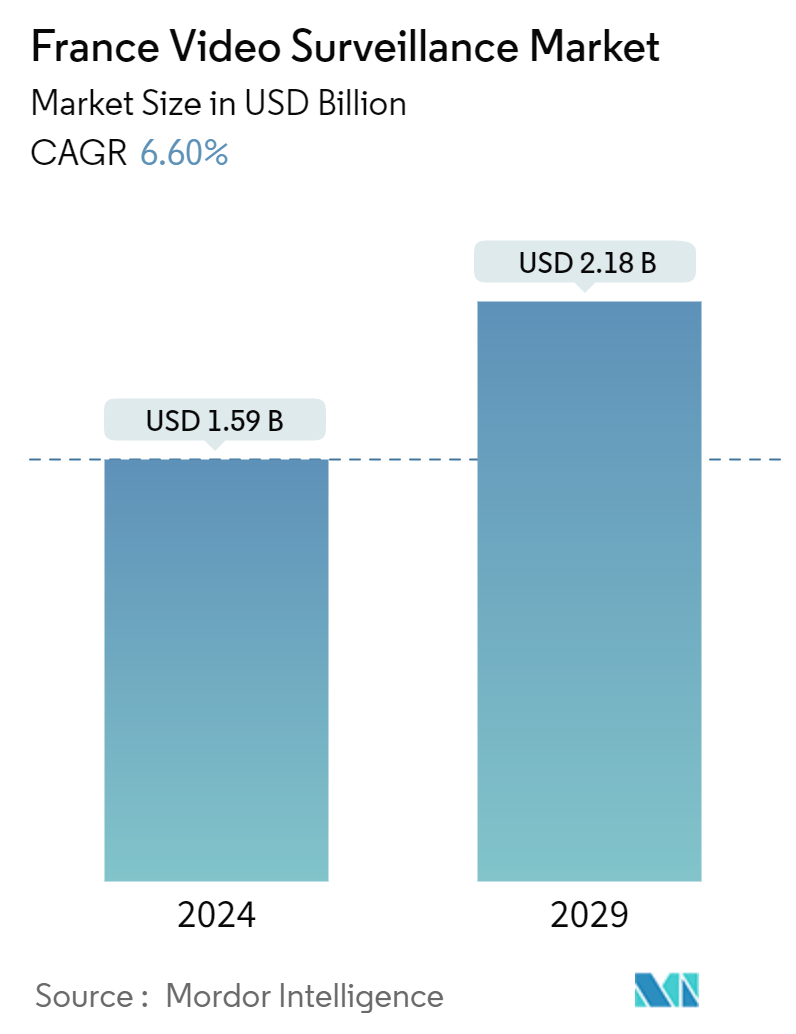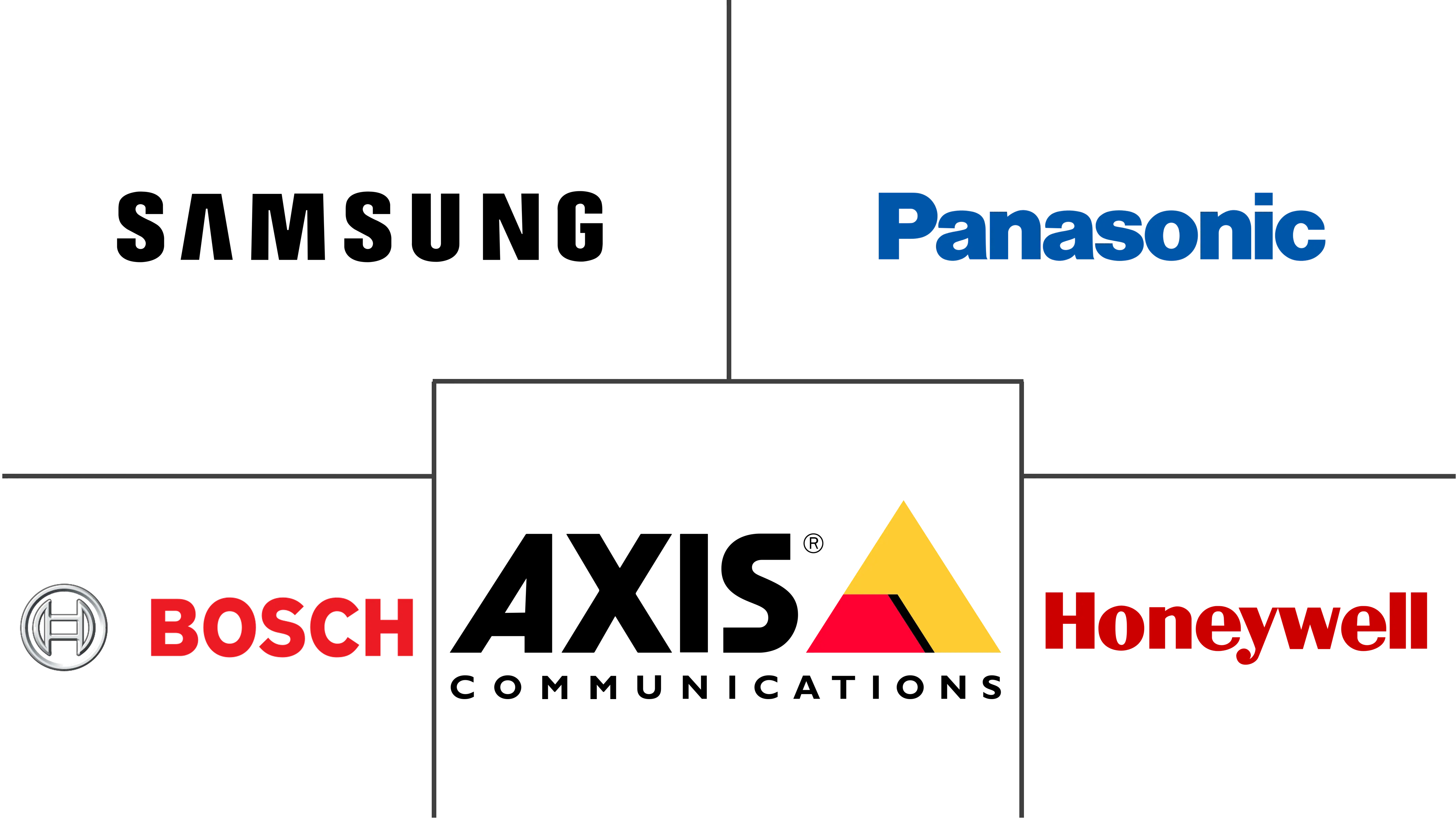Market Size of France Video Surveillance Industry

| Study Period | 2022 - 2029 |
| Base Year For Estimation | 2023 |
| Market Size (2024) | USD 1.59 Billion |
| Market Size (2029) | USD 2.18 Billion |
| CAGR (2024 - 2029) | 6.60 % |
| Market Concentration | Low |
Major Players
*Disclaimer: Major Players sorted in no particular order |
France Video Surveillance Market Analysis
The France Video Surveillance Market size is estimated at USD 1.59 billion in 2024, and is expected to reach USD 2.18 billion by 2029, growing at a CAGR of 6.60% during the forecast period (2024-2029).
The landscape of public safety has been transformed by technological advancements in recent years, especially video monitoring. Once a mere tool for after-the-fact investigation, these systems are increasingly playing a proactive role in crime prevention and safety management. Initially, video cameras were installed as deterrents. However, their presence has become so normalized that their mere existence no longer deters criminal behavior as effectively. Moreover, in France, the market is significantly promoted by the rising importance of safety and security.
Given the rise in safety and security concerns, enterprises in all industry verticals and individuals are investing in video surveillance. For instance, the majority of rural communities are turning to CCTV and video surveillance technology in the form of aid to combat rising crime. This is because about 300 locations across the country have registered violence this summer, which was further followed by rioting in Paris after the shooting of a teenager by police. Notably, mayors in rural areas have also been getting targeted with verbal and physical abuse in recent years. In the first three months of 2023, about 900 acts of violence against elected officials were reported, as per a French English newspaper.
Thus, rural mayors in southeast France are the latest to adopt such technology, with plans underway for a centralized surveillance hub to monitor several locations simultaneously. For instance, the Alpes-Maritimes-based project utilized the existing systems at an administrative center near Nice, and their trained officers are required to continuously examine CCTV footage from various locations simultaneously. Moreover, the Cannes mayor, who is also president of the French mayors’ association, and the Mayor of Grasse have both backed the plan. About 10 municipalities have already shown their interest in signing up to the project.
However, privacy concerns are arising among the population due to the rising incorporation of advanced technologies into the video surveillance market. For instance, France is reportedly experimenting with AI-driven video surveillance to be used during the Paris 2024 Olympics. The move followed the legislation passed in 2023, allowing AI video surveillance for a trial period during large-scale events. Videtics, Orange Business, ChapsVision, and Wintics developed AI software that uses algorithms to analyze real-time video streams from existing surveillance systems. However, France’s surveillance plans for the 2024 Olympics are raising privacy concerns among people as proponents argue these systems will prevent terrorist attacks and privacy advocates warn of a “techno-securitarian drift” in France.
This is further supported by the government and judicial bodies of the country. For instance, the highest constitutional court in France issued a decision supporting the use of AI-powered surveillance cameras for the 2024 Paris Olympics despite privacy concerns. Such factors present the positive growth prospects of the French market.
France Video Surveillance Industry Segmentation
Video surveillance systems contain one or more video cameras connected to a network that sends the captured video or audio data to a specific location. The captured images are monitored in real-time or sent to a central location for recording and storage. Many applications, such as crime prevention, industrial process monitoring, and traffic management, use video surveillance systems. The market size encompasses the revenue accrued from the sale of video surveillance systems by various vendors in the country.
The French video surveillance market is segmented by type (hardware [camera (analog, IP cameras, and hybrid) and storage], software [video analytics and video management software], and services [VSaaS]) and end-user vertical (commercial, infrastructure, institutional, industrial, defense, and residential). The market sizes and forecasts are provided in terms of value (USD) for all the segments.
| By Type | ||||||||
| ||||||||
| ||||||||
| Services (VSaaS) |
| By End User Vertical | |
| Commercial | |
| Infrastructure | |
| Institutional | |
| Industrial | |
| Defense | |
| Residential |
France Video Surveillance Market Size Summary
The French video surveillance market is experiencing significant growth, driven by increasing safety and security concerns across various sectors. Technological advancements have transformed video monitoring from a reactive tool to a proactive measure in crime prevention and safety management. The market is further bolstered by the rising adoption of surveillance systems in rural areas, where communities are investing in CCTV and video surveillance technology to combat crime. This trend is supported by government initiatives and financial grants aimed at enhancing public safety, particularly in regions with high crime rates. The market's expansion is also influenced by the integration of advanced technologies, such as AI-driven surveillance systems, which are being tested for large-scale events like the Paris 2024 Olympics, despite ongoing privacy concerns.
The French video surveillance industry is characterized by a fragmented landscape with major players like Panasonic, Samsung, Honeywell, and Bosch leading the market. These companies are leveraging partnerships, innovations, and strategic investments to enhance their product offerings and maintain a competitive edge. Recent collaborations, such as Hikvision's partnership with Can'nX and Ajax Systems' alliance with Serviacom, highlight the industry's focus on integrating advanced technologies into building automation and security solutions. Additionally, the market is witnessing the introduction of cutting-edge products, such as FUJIFILM's long-range surveillance camera system, which underscores the ongoing innovation and adaptation to evolving security needs. As urbanization continues to rise, video surveillance remains a crucial investment for securing properties, public spaces, and events in France.
France Video Surveillance Market Size - Table of Contents
-
1. MARKET INSIGHTS
-
1.1 Market Overview
-
1.2 Industry Value Chain Analysis
-
1.3 Industry Attractiveness - Porter's Five Forces Analysis
-
1.3.1 Bargaining Power of Suppliers
-
1.3.2 Bargaining Power of Consumers
-
1.3.3 Threat of New Entrants
-
1.3.4 Threat of Substitute Products
-
1.3.5 Intensity of Competitive Rivalry
-
-
1.4 Impact of Macro Economic Trends on the Market
-
-
2. MARKET SEGMENTATION
-
2.1 By Type
-
2.1.1 Hardware
-
2.1.1.1 Camera
-
2.1.1.1.1 Analog
-
2.1.1.1.2 IP Cameras
-
2.1.1.1.3 Hybrid
-
-
2.1.1.2 Storage
-
-
2.1.2 Software
-
2.1.2.1 Video Analytics
-
2.1.2.2 Video Management Software
-
-
2.1.3 Services (VSaaS)
-
-
2.2 By End User Vertical
-
2.2.1 Commercial
-
2.2.2 Infrastructure
-
2.2.3 Institutional
-
2.2.4 Industrial
-
2.2.5 Defense
-
2.2.6 Residential
-
-
France Video Surveillance Market Size FAQs
How big is the France Video Surveillance Market?
The France Video Surveillance Market size is expected to reach USD 1.59 billion in 2024 and grow at a CAGR of 6.60% to reach USD 2.18 billion by 2029.
What is the current France Video Surveillance Market size?
In 2024, the France Video Surveillance Market size is expected to reach USD 1.59 billion.

